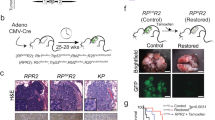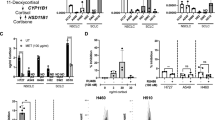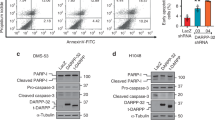Abstract
Small cell lung cancer (SCLC) is an aggressive tumour with an abysmal prognosis. These cancers are characteristically resistant to glucocorticoid (Gc) action, owing to impaired expression of the glucocorticoid receptor (GR). We identified reduced GR expression in human SCLC cell lines, compared to a non-SCLC cell line. The SCLC cells also showed no Gc inhibition of proliferation, in contrast to non-SCLC cells. Retroviral overexpression of GR resulted in significantly increased cell death, which was partially blocked by the GR antagonist, RU486. Indeed, in cells sorted for GR expression, there was rapid, near complete loss of live cells by 72 h, in contrast to control cells that proliferated as expected. Flow cytometry using Annexin V revealed that cell death was by apoptosis. In addition, confocal analysis of fixed cells showed that cells overexpressing GR displayed a significant increase in fragmenting apoptotic nuclei. Microarray studies showed that transgenic GR expression upregulated the proapoptotic genes, BAD and BAX. We have, therefore, identified a profound apoptotic effect of GR in SCLC cells, which may explain the low levels of endogenous GR in SCLC cells. Understanding how GR overexpression leads to apoptotic cell death in SCLC cells may uncover new therapeutic strategies.
This is a preview of subscription content, access via your institution
Access options
Subscribe to this journal
Receive 50 print issues and online access
$259.00 per year
only $5.18 per issue
Buy this article
- Purchase on Springer Link
- Instant access to full article PDF
Prices may be subject to local taxes which are calculated during checkout








Similar content being viewed by others
References
Baldi P, Long AD . (2001). A Bayesian framework for the analysis of microarray expression data: regularized t-test and statistical inferences of gene changes. Bioinformatics 17: 509–519.
Bolstad BM, Irizarry RA, Astrand M, Speed TP . (2003). A comparison of normalization methods for high density oligonucleotide array data based on variance and bias. Bioinformatics 19: 185–193.
Braunschweiger PG, Ting HL, Schiffer LM . (1983). Correlation between glucocorticoid receptor content and the anti-proliferative effect of dexamethasone in experimental solid tumors. Cancer Res 43: 4757–4761.
Clark AJL, Stewart MF, Lavender PM, Farrell W, Crosby SR, Rees LH et al. (1990). Defective glucocorticoid regulation of proopiomelanocortin gene-expression and peptide secretion in a small cell lung-cancer cell-line. J Clin Endocrinol Metabol 70: 485–490.
Cole TJ, Blendy JA, Monaghan AP, Krieglstein K, Schmid W, Aguzzi A et al. (1995). Targeted disruption of the glucocorticoid receptor gene blocks adrenergic chromaffin cell-development and severely retards lung maturation. Genes Dev 9: 1608–1621.
Crosby SR, Stewart MF, Ratcliffe JG, White A . (1988). Direct measurement of the precursors of adrenocorticotropin in human-plasma by 2-site immunoradiometric assay. J Clin Endocrinol Metabol 67: 1272–1277.
Donn R, Berry A, Stevens A, Farrow S, Betts J, Stevens R et al. (2007). Use of gene expression profiling to identify a novel glucocorticoid sensitivity determining gene, BMPRII. FASEB J 21: 402–414.
Doucas V, Shi Y, Miyamoto S, West A, Verma I, Evans RM . (2000). Cytoplasmic catalytic subunit of protein kinase A mediates cross-repression by NF-kappa B and the glucocorticoid receptor. Proc Natl Acad Sci USA 97: 11893–11898.
Farrell WE, Stewart MF, Clark AJL, Crosby SR, Davis JRE, White A . (1993). Glucocorticoid inhibition of Acth peptides – small-cell lung-cancer cell-lines are more resistant than pituitary corticotroph adenoma cells. J Mol Endocrinol 10: 25–32.
Galon J, Franchimont D, Hiroi N, Frey G, Boettner A, Ehrhart-Bornstein M et al. (2002). Gene profiling reveals unknown enhancing and suppressive actions of glucocorticoids on immune cells. FASEB J 16: 61–71.
Garside H, Stevens A, Farrow S, Normand C, Houle B, Berry A et al. (2004). Glucocorticoid ligands specify different interactions with NF-kappaB by allosteric effects on the glucocorticoid receptor DNA binding domain. J Biol Chem 279: 50050–50059.
Goya L, Maiyar AC, Ge Y, Firestone GL . (1993). Glucocorticoids induce a G1/G0 cell-cycle arrest of Con8 rat mammary-tumor cells that Is synchronously reversed by steroid withdrawal or addition of transforming growth-factor-alpha. Mol Endocrinol 7: 1121–1132.
Harmon JM, Norman MR, Fowlkes BJ, Thompson EB . (1979). Dexamethasone induces irreversible G1 arrest and death of a human lymphoid-cell line. J Cell Physiol 98: 267–278.
Hernandez J, Carrasco J, Belloso E, Giralt M, Bluethmann H, Kee Lee D et al. (2000). Metallothionein induction by restraint stress: role of glucocorticoids and IL-6. Cytokine 12: 791–796.
Herr I, Ucur E, Herzer K, Okouoyo S, Ridder R, Krammer PH et al. (2003). Glucocorticoid cotreatment induces apoptosis resistance toward cancer therapy in carcinomas. Cancer Res 63: 3112–3120.
Hofmann J, Kaiser U, Maasberg M, Havemann K . (1995). Glucocorticoid receptors and growth inhibitory effects of dexamethasone in human lung cancer cell lines. Eur J Cancer 31A: 2053–2058.
Jackman DM, Johnson BE . (2005). Small-cell lung cancer. Lancet 366: 1385–1396.
Kim CFB, Jackson EL, Woolfenden AE, Lawrence S, Babar I, Vogel S et al. (2005). Identification of bronchioalveolar stem cells in normal lung and lung cancer. Cell 121: 823–835.
Kim YH, Girard L, Giacomini CP, Wang P, Hernandez-Boussard T, Tibshirani R et al. (2006). Combined microarray analysis of small cell lung cancer reveals altered apoptotic balance and distinct expression signatures of MYC family gene amplification. Oncogene 25: 130–138.
Kofler R . (2000). The molecular basis of glucocorticoid-induced apoptosis of lymphoblastic leukemia cells. Histochem Cell Biol 114: 1–7.
Leis H, Page A, Ramirez A, Bravo A, Segrelles C, Paramio J et al. (2004). Glucocorticoid receptor counteracts tumorigenic activity of Akt in skin through interference with the phosphatidylinositol 3-kinase signaling pathway. Mol Endocrinol 18: 303–311.
Li C, Wong WH . (2001). Model-based analysis of oligonucleotide arrays: expression index computation and outlier detection. Proc Natl Acad Sci USA 98: 31–36.
Livak KJ, Schmittgen TD . (2001). Analysis of relative gene expression data using real-time quantitative PCR and the 2(T)(-Delta Delta C) method. Methods 25: 402–408.
Lu YS, Lien HC, Yeh PY, Yeh KH, Kuo ML, Kuo SH et al. (2005). Effects of glucocorticoids on the growth and chemosensitivity of carcinoma cells are heterogeneous and require high concentration of functional glucocorticoid receptors. World J Gastroenterol 11: 6373–6380.
Mathieu M, Gougat C, Jaffuel D, Danielsen M, Godard P, Bousquet J et al. (1999). The glucocorticoid receptor gene as a candidate for gene therapy in asthma. Gene Ther 6: 245–252.
Minna JD, Kurie JM, Jacks T . (2003). A big step in the study of small cell lung cancer. Cancer Cell 4: 163–166.
Mitelman F . (2000). Recurrent chromosome aberrations in cancer. Mutat Res 462: 247–253.
Mok CL, Gil-Gomez G, Williams O, Coles M, Taga S, Tolaini M et al. (1999). Bad can act as a key regulator of T cell apoptosis and T cell development. J Exp Med 189: 575–586.
Mortenson MM, Schlieman MG, Virudachalam S, Lara PN, Gandara DG, Davies AM et al. (2005). Reduction in BCL-2 levels by 26S proteasome inhibition with bortezomib is associated with induction of apoptosis in small cell lung cancer. Lung Cancer 49: 163–170.
Norman J, Franz M, Schiro R, Nicosia S, Docs J, Fabri PJ et al. (1994). Functional glucocorticoid receptor modulates pancreatic-carcinoma growth through an autocrine loop. J Surg Res 57: 33–38.
Norman MR, Thompson EB . (1977). Characterization of a glucocorticoid-sensitive human lymphoid-cell line. Cancer Res 37: 3785–3791.
Pang D, Conzen SD . (2004). Association of glucocorticoid receptor signaling with decreased effectiveness of chemotherapy in a breast cancer xenograft model. Breast Cancer Res Treat 88: S27–S28.
Ray DW, Davis JRE, White A, Clark AJL . (1996). Glucocorticoid receptor structure and function in glucocorticoid-resistant small cell lung carcinoma cells. Cancer Res 56: 3276–3280.
Ray DW, Littlewood AC, Clark AJL, Davis JRE, White A . (1994). Human small-cell lung-cancer cell-lines expressing the proopiomelanocortin gene have aberrant glucocorticoid receptor function. J Clin Investig 93: 1625–1630.
Reichardt HM, Kaestner KH, Tuckermann J, Kretz O, Wessely O, Bock R et al. (1998). DNA binding of the glucocorticoid receptor is not essential for survival. Cell 93: 531–541.
Rogatsky I, Hittelman AB, Pearce D, Garabedian MJ . (1999). Distinct glucocorticoid receptor transcriptional regulatory surfaces mediate the cytotoxic and cytostatic effects of glucocorticoids. Mol Cell Biol 19: 5036–5049.
Rogatsky I, Trowbridge JM, Garabedian MJ . (1997). Glucocorticoid receptor-mediated cell cycle arrest is achieved through distinct cell-specific transcriptional regulatory mechanisms. Mol Cell Biol 17: 3181–3193.
Sanchez I, Goya L, Vallerga AK, Firestone GL . (1993). Glucocorticoids reversibly arrest rat hepatoma-cell growth by inducing an early G(1) block in cell-cycle progression. Cell Growth Differ 4: 215–225.
Schmidt S, Rainer J, Ploner C, Presul E, Riml S, Kofler R . (2004). Glucocorticoid-induced apoptosis and glucocorticoid resistance: molecular mechanisms and clinical relevance. Cell Death Differ 11: S45–S55.
Tamura K, Miwa W, Maruyama T, Sekiya T, Murakami Y . (2002). Homozygous deletion on the chromosomal region 5q12.3 in human lines of small-cell lung cancers. J Hum Genetics 47: 348–354.
Wang Z, Garabedian MJ . (2003). Modulation of glucocorticoid receptor transcriptional activation, phosphorylation, and growth inhibition by p27(Kip1). J Biol Chem 278: 50897–50901.
White A, Clark AJL . (1993). The cellular and molecular-basis of the ectopic Acth syndrome. Clin Endocrinol 39: 131–141.
White A, Clark AJL, Stewart MF . (1990). The synthesis of Acth and related peptides by tumors. Baillieres Clin Endocrinol Metabol 4: 1–27.
Witschi H, Espiritu I, Ly M, Uyeminami D . (2005). The chemopreventive effects of orally administered dexamethasone in strain A/J mice following cessation of smoke exposure. Inhal Toxicol 17: 119–122.
Wu W, Chaudhuri S, Brickley DR, Pang D, Karrison T, Conzen SD . (2004). Microarray analysis reveals glucocorticoid-regulated survival genes that are associated with inhibition of apoptosis in breast epithelial cells. Cancer Res 64: 1757–1764.
Zhu XY, Liu YJ, Lu J, Xu RB . (2004). Knockdown of glucocorticoid receptor expression by RNA interference promotes cell proliferation in murine macrophage RAW264.7 cells. J Steroid Biochem Mol Biol 92: 375–382.
Acknowledgements
We are grateful to the Wellcome Trust for funding. DWR was supported by a GSK fellowship. The MRC funded a studentship for T Huynh. We are grateful to Dr J Freeth (AstraZeneca), Dr T Southgate (Paterson Institute for Cancer Research) for helpful advice and reagents, and to Dr Leo Zeef for his bioinformatic analysis of the array data.
Author information
Authors and Affiliations
Corresponding authors
Rights and permissions
About this article
Cite this article
Sommer, P., Le Rouzic, P., Gillingham, H. et al. Glucocorticoid receptor overexpression exerts an antisurvival effect on human small cell lung cancer cells. Oncogene 26, 7111–7121 (2007). https://doi.org/10.1038/sj.onc.1210524
Received:
Revised:
Accepted:
Published:
Issue Date:
DOI: https://doi.org/10.1038/sj.onc.1210524
Keywords
This article is cited by
-
Glucocorticoid receptor triggers a reversible drug-tolerant dormancy state with acquired therapeutic vulnerabilities in lung cancer
Nature Communications (2021)
-
The tobacco carcinogen NNK drives accumulation of DNMT1 at the GR promoter thereby reducing GR expression in untransformed lung fibroblasts
Scientific Reports (2018)
-
A searchable cross-platform gene expression database reveals connections between drug treatments and disease
BMC Genomics (2012)
-
The role of glucocorticoid receptor phosphorylation in Mcl-1 and NOXA gene expression
Molecular Cancer (2010)
-
Overexpression of Glucocorticoid Receptor in Human Pancreatic Cancer and in Xenografts. An Immunohistochemical Study
Pathology & Oncology Research (2009)



